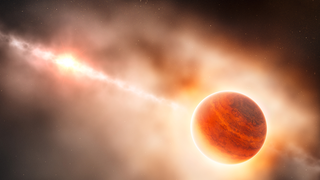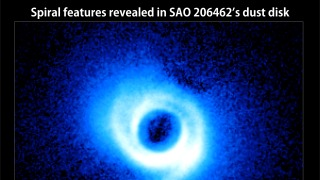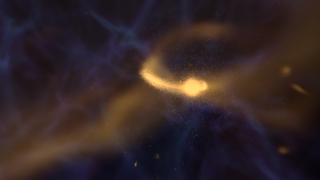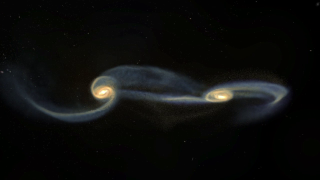Webb Science Simulations: Planetary Systems and Origins of Life
Part 1: Turbulent Molecular Cloud Nebula with Protostellar Objects
The Advanced Visualization Laboratory (AVL) at the National Center for Supercomputing Applications (NCSA) collaborated with NASA and Drs. Alexei Kritsuk and Michael Norman to visualize a computational data set of a turbulent molecular cloud nebula forming protostellar objects and accretion disks approximately 100 AU in diameter, on the order of the size of our solar system. AVL used its Amore software to interpolate and render the Adaptive Mesh Refinement (AMR) simulation generated from ENZO code for cosmology and astrophysics. The AMR simulation was developed by Drs. Kritsuk and Norman at the Laboratory for Computational Astrophysics.
The AMR simulation generated more than 2 terabytes of data and follows star formation processes in a self-gravitating turbulent molecular cloud with a dynamic range of half-a-million in linear scale, resolving both the large-scale filamentary structure of the molecular cloud (~5 parsec) and accretion disks around emerging young protostellar objects (down to 2 AU).
Part 2: Protoplanetary Disk and Planet Formation
The Advanced Visualization Laboratory (AVL) at the National Center for Supercomputing Applications (NCSA) collaborated with NASA and Dr. Aaron Boley to visualize the 16,000 year evolution of a young, isolated protoplanetary disk which surrounds a newly-formed protostar. The disk forms spiral arms and a dense clump as a result of gravitational collapse. Dr. Aaron Boley developed this computational model to investigate the response of young disks to mass accretion from their surrounding envelopes, including the direct formation of planets and brown dwarfs through gravitational instability.
The main formation mechanism for gas giant planets has been debated within the scientific community for over a decade. One of these theories is 'direct formation through gravitational instability.' If the self-gravity of the gas overwhelms the disk's thermal pressure and the stabilizing effect of differential rotation, the gas closest to the protostar rotates faster than gas farther away. In this scenario, regions of the gaseous disk collapse and form a planet directly. The study, presented in Boley (2009), explores whether mass accretion in the outer regions of disks can lead to such disk fragmentation. The simulations show that clumps can form in situ at large disk radii. If the clumps survive, they can become gas giants on wide orbits, e.g., Fomalhaut b, or even more massive objects called brown dwarfs. Whether a disk forms planets at large radii and, if so, the number of planets that form, depend on how much of the envelope mass is distributed at large distances from the protostar.
The results of the simulations suggest that there are two modes of gas giant planet formation. The first mode occurs early in the disk's lifetime, at large radii, and through the disk instability mechanism. After the main accretion phase is over, gas giants can form in the inner disk, over a period of a million years, through the core accretion mechanism, which researchers are addressing in other studies.
Thanks to R. H. Durisen, L. Mayer, and G. Lake for comments and discussions relating to this research. This study was supported in part by the University of Zurich, Institute for Theoretical Physics, and by a Swiss Federal Grant. Resources supporting this work were provided by the NASA High-End Computing (HEC) Program through the NASA Advanced Supercomputing (NAS) Division at Ames Research Center.
Related
Credits
Stuart Levy (AVL NCSA/University of Illinois): Animator
Matthew Hall (AVL NCSA/University of Illinois): Animator
Robert Patterson (AVL NCSA/University of Illinois): Animator
A. J. Christensen (AVL NCSA/University of Illinois): Animator
Alex Betts (AVL NCSA/University of Illinois): Animator
Michael McClare (HTSI): Producer
Donna Cox (AVL NCSA/University of Illinois): Producer
Aaron C. Boley (University of Florida): Scientist
Alexei Kritsuk (University of California, San Diego): Scientist
Michael Norman (University of California, San Diego): Scientist
NASA/Goddard Space Flight Center, the Advanced Visualization Laboratoy at the National Center for Supercomputing Applications, A. Boley, A. Kritsuk and M. Norman
On the Density Distribution in Star-forming Interstellar Clouds, Alexei G. Kritsuk, Michael L. Norman, Rick Wagner, APJL submitted 2010 & The Two Modes of Gas Giant Planet Formation, Boley, Aaron C., The Astrophysical Journal Letters, Volume 695, Issue 1, pp. L53-L57 (2009)
Short URL to share this page:
https://svs.gsfc.nasa.gov/10662
Mission:
James Webb Space Telescope - JWST
This item is part of this series:
Astrophysics Simulations
Goddard TV Tapes:
G2010-014 -- JWST Media Resource Reel 2010
G2010-070 -- JWST Science Animations
Keywords:
SVS >> HDTV
DLESE >> Space science
SVS >> Hyperwall
SVS >> Hubble Space Telescope
SVS >> JWST
SVS >> Planets
SVS >> Space
SVS >> Evolution
SVS >> Webb Telescope
SVS >> Star
SVS >> Planetary Science
SVS >> Hydrodynamic Simulation
SVS >> Re-ionization
SVS >> Protoplanetary Disk
SVS >> Molecular Cloud
SVS >> Brown Dwarf
SVS >> James Webb Space Telescope
NASA Science >> Planets and Moons
NASA Science >> Universe















